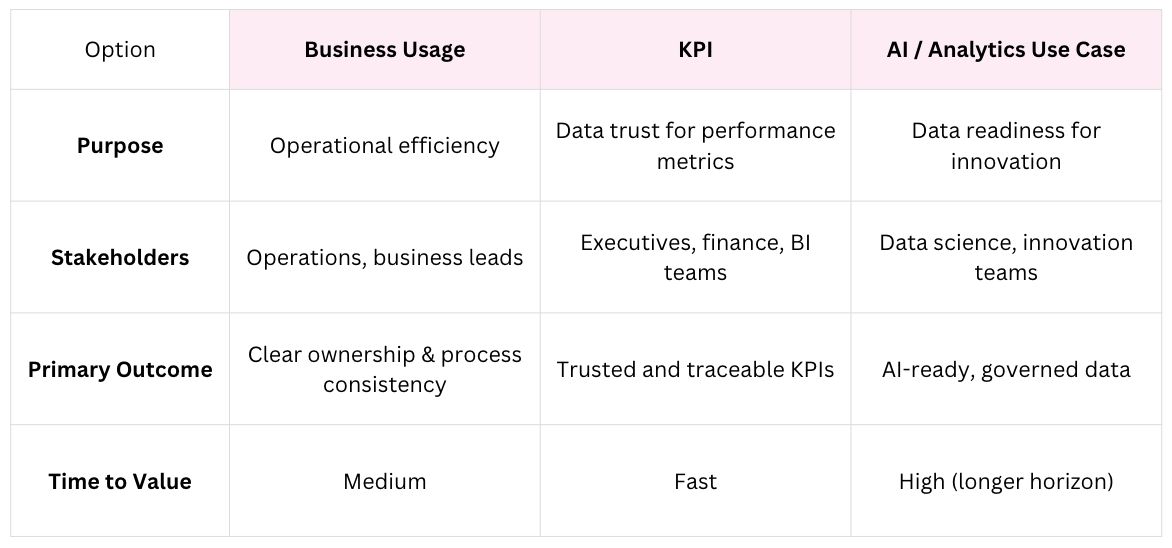Launch a first Data Domain
#37 Lay the foundations
Hello 😀
You’ve mapped (more or less) your domains, but now people are asking you what it really means to setup a data domain and what they’ll have to do.

Join my online Data Governance Training
Play the Chief Data Officer simulation game
Ask us for custom Data Literacy & Training games
Get my Data Governance templates
Discover my consulting & coaching services
Join +290 readers of “Data Governance : where to start?”
Get a boost with a 4 weeks training on Generative AI
Build vs Buy your Data Product Marketplace?
Don’t decide in the dark.
Discover the complete, battle-tested guide from Huwise that helps data leaders make the right call : whether to build in-house or adopt a SaaS data product marketplace.
You’ll find :
Clear criteria
Real-world scenarios with key numbers
10 guided questions to know if you’re buy-ready
Upcoming Event: Reimagine The Future of How You Work with Data
We’re proud to feature Collate‘s upcoming Reimagine Virtual Summit featuring Suresh Srinivas (Former Chief Data Architect at Uber, Co-founder of Hadoop/Hortonworks) for exclusive demos of AI agents as data teammates, conversational DataOps, and agentic automation. Perfect for CDAOs, data leaders, governance teams, and platform engineers ready to see tomorrow’s data stack today.
📆 When : October 22, 2025 - 9:00-10:30AM PST
Let’s see how to proceed 👇
Agenda
The very first Data Domain
How to start & act
Option 1 : Start from Business usage
Option 2 : Start from key KPIs
Option 3 : Start from AI use cases
The very first Data Domain
You don’t need to wait until your Data Domain map is finished. Because *spoiler alert*, it will never be fully.
What you need above all to start is a Data Sponsor.
Meaning a Head of Business department : Marketing, Logistics, HR, Operations, Strategy, Sales, etc - that will support the initiative and be at the top of your Data Domain.
👉 I mentioned in a previous edition 5 ideas to get Data Governance sponsors, it’s still valuable !
In any case, as a first data domain, I’d recommend something meaningful : choose a business area where data is already critical to decision-making, and where improvements will have noticeable impact. Then :
Define the why of your domain framework (accountability for quality, business alignment, domains autonomy, etc.)
Establish data ownership early on. Assign clear roles for stewardship and governance.
🔍 Checkout here the full templates to define your data domain framework.
You should at least have a rough vision of the different roles that are expected within the data domain. And for sure, the ways the domain will interact with other domains and IT, but wait - that’s an idea for another newsletter 😈
How to start & act
There’s no single right way to begin.
In my opinion, there are 3 valid entry points to start establishing a data domain.
Option 1️⃣ : Start from Business Usage
This one is focused on how data is used in daily operations, all along the business value chain of the company.
Steps
Identify the key business processes managed by your Data Sponsor.
Map the critical data objects used in those processes.
Find pain points related to these data objects : are they complete? accurate? causing issues with the customers?
Define the stewardship roles for these objects.
Start the work on data quality rules and definitions.
Example
Customer Domain :
Supports the process : Customer Onboarding
Key data : Customer profile, contact info, relationship status.
Sponsor : Head of Customer Operations.
🧭 When to choose this path :
Your organization is business process-driven (e.g., order management, supply chain, customer service). Industrial companies are highly concerned.
You aim to reduce redundancy and improve end-to-end data consistency.
Option 2️⃣ : Start from key KPIs
This option is about building the domain around the data needed to measure strategic performance.
This approach connects governance directly to what executives care about most : trusted metrics and reliable insights.
Steps
Identify the 3 KPIs that are critical for the performance of the Data Sponsor.
Trace the data sources and lineage for each KPI.
Identify which data elements are part of this first Domain.
Define the stewardship roles for these elements.
Start the work on calculation rules, data quality rules and definitions.
Example
Customer Domain :
Supports the process : Customer Onboarding
Key KPIs : time to value, onboarding completion rate, early activation rate.
Key data element : contract_start_date, onboarding_status, etc.
Sponsor : Head of Customer Operations.
🧭 When to choose this path :
Leadership is data-driven and demands consistent metrics.
You need quick wins to prove the value of data governance.
Option 3️⃣ : Start from AI or Analytics use cases
The idea here is to create domains to ensure high quality data for AI or advanced analytics initiatives. The domain is based on data needed for these use cases.
Steps
Identify priority AI use cases or analytics models with your Data Sponsor.
Document data inputs, features, and targets.
Determine which data elements appear most frequently among models.
Define the stewardship roles for these elements.
Start the work on establishing controls for lineage, quality, and bias checks.
Example
Customer Domain :
AI Use Cases : Churn prediction, personalized recommendations.
Data used : Transactions, engagement, demographics, support interactions.
Sponsor : Head of Customer Operations.
🧭 When to choose this path :
You’re launching or expanding AI projects (e.g., recommendation engines, predictive analytics).
You want reliable, traceable training data.
Your organization is ready to launch more than one domain. As you can see here, the data used for your AI use cases will come from different domains : transactions from Sales, support interactions from Customer Service, …
Here is the recap of the 3 options to launch your data domain :
But don’t forget that you can, at anytime, blend all 3 approaches !
See you soon,
Charlotte
I’m Charlotte Ledoux, freelance in Data & AI Governance.
You can follow me on Linkedin !


